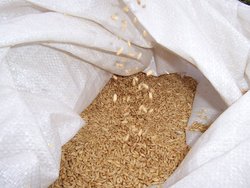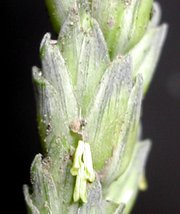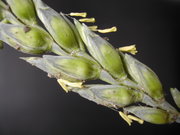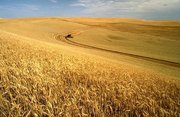Wheat
|
|
| Wheat | ||||||||||||
|---|---|---|---|---|---|---|---|---|---|---|---|---|
 | ||||||||||||
| Scientific classification | ||||||||||||
|
Wheat (Triticum spp.) is a grass that is cultivated around the world. Globally, it is the second-largest cereal crop behind maize; the third being rice. Wheat grain is a staple food used to make flour, livestock feed and as an ingredient in the brewing of beer. The husk can be separated and ground into bran. Wheat is also planted strictly as a forage crop for livestock and hay.
It is thought that wheat was first domesticated in the Fertile Crescent area of the Middle East.
| Contents |
Cultivars
Wheat cultivars are classified by growing season (winter wheat vs. spring wheat) and by gluten content (hard wheat (high gluten content) vs. soft wheat (high starch content)).
Major cultivar groups of wheat
- Common Wheat - (T. aestivum) A hexaploid species that is the most widely cultivated in the world.
- Einkorn - (T. monococcum) A diploid species with wild and cultivated variants. One of the earliest cultivated but rarely planted today.
- Emmer - (T. turgidum var. dicoccum) A tetraploid species, with wild and cultivated variants. Cultivated in ancient times but no longer in widespread usage.
- Durum - (T. turgidum var. durum) The only tetraploid form of wheat widely used today.
- Kamut® or QK-77 - (T. turgidum var. polonicum) A tetraploid species grown in small quantities that is extensively marketed. Originally from the Middle East
- Spelt - (T. spelta) Another hexaploid species cultivated in limited quantities.
History
Domestic wheat originated in southwest Asia. The oldest archaeological evidence for wheat cultivation comes from Syria, Jordan, Turkey, and Iraq. Around 8,000 years ago, a mutation or hybridization occurred within emmer, resulting in a plant with seeds that were larger, but could not sow themselves on the wind (see domestication). While this plant could not have succeeded in the wild, it produced more food for humans, and within cultivated fields, it outcompeted plants with smaller, self-sowing seeds to become the ancestor of modern wheat.
The cultivation of wheat began to spread into Europe beginning in the Neolithic.
Production and consumption statistics
In the 2004 crop year, global wheat production totalled 624 million tonnes and the top wheat producing countries were:
- China: 91,3 million tonnes
- India: 72 million tonnes
- United States: 58.8 million tonnes
- Russian Federation: 42.2 million tonnes
- France: 39 million tonnes
- Germany: 25.3 million tonnes
- Australia: 22.5 million tonnes
1997 global per capita wheat consumption was 101 kg, led by Denmark at 623 kg.
Past International wheat production statistics.
Agronomy
Crop development
Crop management decisions require the knowledge of stage of development of the crop. In particular, spring fertilizers applications, herbicides, fungicides, growth regulators are typically applied at specific stages of plant development.
For example, current recommendations often indicate the second application of nitrogen be done when the ear (not visible at this stage) is about 1 cm in size (Z31 on Zadok scale). Knowledge of stages is also interesting to identify periods of higher risk, in terms of climate. For example, the me�osis stage is extremely suceptible to low temperatures (under 4 �C) or high temperatures (over 25 �C). Farmers also benefit from knowing when the flag leaf (last leaf) appears as this leaf represents about 75% of photosynthesis reactions during the grain filling period and as such should be preserved from disease or insect attacks to ensure a good yield.
Several systems exist to identify crop stages, with the Feekes and Zadoks scales being the most widely used. Each scale is a standard system which describes successive stages reached by the crop during the agricultural season.
Wheat stages
- Wheat at the anthesis stage (face and side view)
Diseases
Wheat is subject to more diseases than other grains, and, in some seasons, especially in wet ones, heavier losses are sustained from those diseases than are felt in the culture of any other culmiferous crop with which we are acquainted. Wheat may suffer from the attack of insects at the root; from blight, which primarily affects the leaf or straw, and ultimately deprives the grain of sufficient nourishment; from mildew on the ear, which operates thereon with the force of an apoplectic stroke; and from gum of different shades, which lodges on the chaff or cups in which the grain is deposited.
Examples of wheat diseases:
Bacterial diseases
- Bacterial leaf blight Pseudomonas syringae subsp. syringae
- Bacterial sheath rot Pseudomonas fuscovaginae
- Basal glume rot Pseudomonas syringae pv. atrofaciens
- Black chaff = bacterial streak Xanthomonas campestris pv. translucens
- Pink seed Erwinia rhapontici
Fungal diseases
- Alternaria leaf blight Alternaria triticina
- Anthracnose Colletotrichum graminicola
- Ascochyta leaf spot Ascochyta tritici
- Black head molds = sooty molds Alternaria spp., Cladosporium spp.
- Common bunt = stinking smut T. tritici, T. laevis
- Downy mildew = crazy top Sclerophthora macrospora
- Dwarf bunt Tilletia controversa
- Ergot Claviceps purpurea
- Foot rot = dryland foot rot Fusarium spp.
- Leaf rust = brown rust Puccinia triticina
- Pink snow mold = Fusarium patch Microdochium nivale
- Powdery mildew = Blumeria graminis
- Scab = head blight Fusarium spp., Gibberella zeae, Microdochium nivale
- Septoria blotch Septoria tritici = Mycospharella graminicola
- Storage moulds Aspergillus spp., Penicillium spp.
Nematodes, parasitic
- Grass cyst nematode Punctodera punctata
- Root gall nematode Subanguina spp.
Viral diseases and viruslike agents
- Agropyron mosaic genus Rymovirus, Agropyron mosaic virus (AgMV)
- Barley stripe mosaic genus Hordeivirus, Barley stripe mosaic virus (BSMV)
- Oat sterile dwarf genus Fijivirus, Oat sterile dwarf virus (OSDV)
- Tobacco mosaic genus Tobamovirus, Tobacco mosaic virus (TMV)
- Wheat dwarf genus Monogeminivirus, Wheat dwarf virus (WDV)
- Wheat yellow mosaic Wheat yellow mosaic bymovirus
Phytoplasmal diseases
- Aster yellows phytoplasma
Link between air pollution and septoria blotch
A team of researchers examined a library of British wheat samples dating back to 1843. For each year, they determined the levels of phaeospheria nodrum and mycospharella graminicola's DNA in the samples. After accounting for influences such as growing and harvesting methods and weather conditions, they compared the DNA data with estimates of emissions of air pollutants. The effect of sulfur dioxide correlated with the abundance of the two fungi. P. nodrum grew more successful with the dawn of the Industrial Revolution. M. graminicola was more abundant before 1870 and since the 1970's. The success since the 1970's is a reflection of reductions in sulfur dioxide emissions due to environmental regulations. (Bearchell, et al., 2005)
Economics
Harvested wheat grain is classified according to grain properties (see below) for the purposes of the commodities market. Wheat buyers use the classifications to help determine which wheat to purchase as each class has special uses. Wheat producers determine which classes of wheat are the most profitable to cultivate with this system.
Wheat is widely cultivated as a cash crop because it produces a good yield per unit area, grows well in a temperate climate even with a moderately short growing season, and yields a versatile, high-quality flour that is widely used in baking. Most breads are made with wheat flour, even many breads named for the other grains they contain, including most rye and oat breads. Many other popular foods are made from wheat flour as well, resulting in a large demand for the grain even in economies with a significant food surplus.
Wheat in the United States
Missing image CombineWheat0654.JPG Combining wheat in Hemingway, South Carolina. |
Classes used in the United States are
- Durum - Very hard, translucent, light colored grain used to make semolina flour for pasta.
- Hard Red Spring - Hard, brownish, high protein wheat used for bread and hard baked goods.
- Hard Red Winter - Hard, brownish, very high protein wheat used for bread, hard baked goods and as an adjunct in other flours to increase protein.
- Soft Red Winter - Soft, brownish, medium protein wheat used for bread.
- Hard White - Hard, light colored, opaque, chalky, medium protein wheat planted in dry, temperate areas. Used for bread and brewing
- Soft White - Soft, light colored, very low protein wheat grown in temperate moist areas. Used for bread.
Hard wheats are harder to process and red wheats may need bleaching. Therefore, soft and white wheats usually command higher prices than hard and red wheats on the commodities market.
Much of the following text is taken from the Household Cyclopedia of 1881:
Wheat may be classed under two principal divisions, though each of these admits of several subdivisions. The first is composed of all the varieties of red wheat. The second division comprehends the whole varieties of white wheat, which again may be arranged under two distinct heads, namely, thick-chaffed and thin-chaffed.
Thick-chaffed wheat varieties were the most widely used before 1799, as they generally make the best quality flour, and in dry seasons, equal the yields of thin-chaffed varieties. However, thick-chaffed varieties are particularly susceptible to mildew, while thin-chaffed varieties are quite hardy and in general are more resistant to mildew. Consequently, a widespread outbreak of mildew in 1799 began a gradual decline in the popularity of thick-chaffed varieties.
See also
- Norin 10 wheat
- Fusarium ear blight or "Wheat Scab"
- Granular material
- Buckwheat - despite its name, it is not wheat




